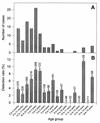Molecular epidemiology of astrovirus infection in Barcelona, Spain
- PMID: 11773106
- PMCID: PMC120088
- DOI: 10.1128/JCM.40.1.133-139.2002
Molecular epidemiology of astrovirus infection in Barcelona, Spain
Abstract
A 3-year study involving 2,347 gastroenteritis samples was conducted to determine the prevalence, time distribution, and medical significance of human astrovirus infection in Barcelona, Spain. The overall incidence of astrovirus was found to be 4.9%. Mixed infections with other enteric agents were detected in 17.2% of all astrovirus-positive samples. During the 3-year period, the highest astrovirus incidence was reported in the winter months, although infections also occurred in summer. The peak detection rate was observed in children between 2 and 4 years of age. Overall, HAstV-1 was the most prevalent type, followed by HAstV-4, HAstV-3, HAstV-8, and HAstV-2. HAstV-5, HAstV-6, and HAstV-7 were not detected during these 3 years. From our serotype data for each age group, we observed that HAstV-1, HAstV-2, and HAstV-3 affected mostly children younger than 3 years of age, while HAstV-4 and HAstV-8 had a greater impact in older children. Genetic variability was analyzed between astroviruses isolated in Barcelona and strains isolated in other parts of the world. A fourth lineage was described for HAstV-1, most likely due to the large number of assayed samples, which may also explain the high level of genetic variability observed in the astrovirus isolates.
Figures





References
-
- Belliot, G., H. Laveran, and S. S. Monroe. 1997. Outbreak of gastroenteritis in military recruits associated with serotype 3 astrovirus infection. J. Med. Virol. 51:101–106. - PubMed
-
- Bon, F., P. Fascia, M. Dauvergne, D. Tenenbaum, H. Planson, A. M. Petion, P. Pothier, and E. Kohli. 1999. Prevalence of group A rotavirus, human calicivirus, astrovirus, and adenovirus type 40 and 41 infections among children with acute gastroenteritis in Dijon, France. J. Clin. Microbiol. 37:3055–3058. - PMC - PubMed
-
- Foley, B., J. O’Mahony, S. M. Morgan, C. Hill, and J. G. Morgan. 2000. Detection of sporadic cases of Norwalk-like virus (NLV) and astrovirus infection in a single Irish hospital from 1996 to 1998. J. Clin. Virol. 17:109–117. - PubMed
Publication types
MeSH terms
Associated data
- Actions
- Actions
- Actions
- Actions
- Actions
- Actions
- Actions
- Actions
- Actions
- Actions
- Actions
- Actions
- Actions
- Actions
- Actions
- Actions
- Actions
- Actions
- Actions
- Actions
- Actions
- Actions
- Actions
- Actions
- Actions
- Actions
- Actions
- Actions
- Actions
- Actions
- Actions
- Actions
- Actions
- Actions
- Actions
- Actions
- Actions
- Actions
- Actions
- Actions
- Actions
- Actions
- Actions
- Actions
- Actions
- Actions
- Actions
- Actions
- Actions
LinkOut - more resources
Full Text Sources
Medical

